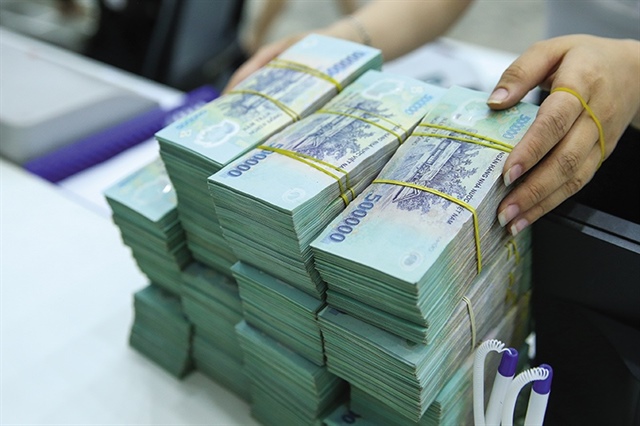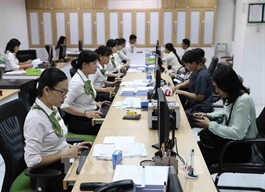Interest rates poised to ease slightly as credit growth accelerates
Interest rates poised to ease slightly as credit growth accelerates
Lending rates in Vietnam may fall by late 2025, with stable funding costs and expected US rate cuts creating room for easing to spur credit and growth.
Market analysts note that while savings deposit rates remain subdued – ranging from 1.6–4.1 per cent annually for 1–3-month terms, 2.9–5.35 per cent for 6–9-month terms, and 3.7–5.6 per cent for 12-month terms – the prospect of lower borrowing costs could stimulate lending and investment activity. Such conditions would strengthen liquidity in the financial system and support Vietnam’s ongoing recovery.
State-owned lenders such as Agribank, Vietcombank, VietinBank, and BIDV are offering even lower deposit rates, with 1.6–1.9 per cent for 1–3-month terms, 2.9–3.5 per cent for 6–9 months, 4.6–4.7 per cent for 12 months, and 4.7–4.8 per cent for longer maturities.
According to a Ministry of Finance report on the socioeconomic situation in August and the first eight months of 2025, stable funding costs have allowed banks to reduce lending rates.
|
As of August 31, the average lending rate dropped to 6.38 per cent, down 0.56 percentage points compared to the end of 2024.
The general outlook, however, remains uncertain, especially as year-end credit demand is expected to rise sharply.
On September 7, the Prime Minister issued Directive No.159/CĐ-TTg, instructing the State Bank of Vietnam (SBV) to coordinate with relevant ministries and sectors to manage monetary policy proactively and flexibly, with a focus on encouraging growth while maintaining macroeconomic stability and controlling inflation.
The SBV has also directed credit institutions to cut operational costs, accelerate digital transformation, reduce lending rates, and channel credit into priority sectors and new growth drivers such as science and technology, innovation, the digital economy, and green and circular economies.
Nguyen Quoc Hung, vice chairman and secretary general of Vietnam Banks Association, noted that Circular No.14/2025/TT-NHNN allows banks more autonomy in risk management, thereby easing interest rate pressures.
“The association will encourage member banks to maintain stable deposit rates and lower lending rates within their capacity, thereby supporting business recovery and production,” he said.
As of the end of August, outstanding credit had reached $685.6 billion, up 11.08 per cent from the end of 2024.
For the whole of 2025, credit growth could reach 20.19 per cent – the highest in many years – compared to the average growth of 14.5 per cent. However, such strong credit expansion may bring two key risks: banks may need to increase capital mobilisation, raising interest rate pressure, while rapid money supply growth could spur medium- to long-term inflation.
According to Nguyen Huu Huan of the University of Economics in Ho Chi Minh City, "If the Fed lowers rates in September meetings (slated for September 16-17) and again in December, exchange rate pressure will ease, creating space for Vietnam to lower interest rates."
"Conversely, if the Fed delays rate cuts, exchange rate pressures will make domestic rate reductions more difficult – especially since Vietnam has limited monetary policy room left," added Huan.
MBS Securities forecasts that input interest rates could fall slightly, down to around 4.7 per cent by the end of the year.
The SBV has also instructed banks to adopt synchronised measures to stabilise and reduce deposit rates, thereby maintaining monetary market stability and creating room for lower lending rates.
Analysts believe that the SBV’s new regulatory tools, combined with expectations of a Fed rate cut in September, will ease pressure on the interbank market and help sustain a low-interest rate policy.
Deposit rates are expected to hover around current levels through the end of 2025. Although seasonal credit demand and exchange rate fluctuations may pose upward pressure, flexible policy management could allow for slight declines in rates.
The United Overseas Bank Limited also projects that while the SBV is unlikely to adjust policy rates in the immediate term, it could reduce them by about 0.5 percentage points if the Fed cuts USD rates in September and the downtrend becomes more apparent by year-end.
In fact, several new advantages are converging: stable input costs, easing exchange rate pressures, broad consensus across the banking system, and decisive policy guidance from both the government and the SBV.
These factors provide a solid foundation for expectations that both deposit and lending rates will remain low – supporting businesses and stimulating aggregate demand in the economy.
Looking ahead to the end of 2025, the interest rate outlook appears stable, with a high likelihood of slight reductions if the Fed adopts a looser policy stance and exchange rate pressures remain under control. This would provide a critical boost to credit growth, support production and business activities, and help sustain macroeconomic stability.
- 14:53 15/09/2025



























